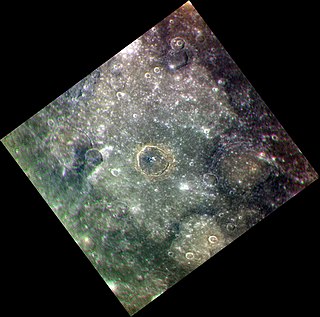
Borealis Planitia is a large plain on Mercury with a smooth floor, thought to be similar to a lunar mare. It is centered at 73.4° N, 79.5° W. The name is Latin for Northern Plain.

Budh Planitia is a large plain on Mercury. It lies to the east of Odin Planitia. It falls within the Tolstoj quadrangle. It was named after the Hindu word for Mercury, Budha, in 1976. The region was first imaged by Mariner 10 in 1974.

Odin Planitia is a large basin on Mercury. It was named after the Norse god Odin, who was sometimes considered to be the equivalent of the Roman god Mercury, in 1976 by the IAU. It was first observed in detail by Mariner 10. The plain is approximately 473 kilometers in diameter.

Tir Planitia is a large plain on the planet Mercury. The name Tir (تیر) is the Persian word for "Mercury", and the name was approved in 1976. It was first observed in detail by Mariner 10. It lies between the large crater Mozart and the ancient Tolstoj basin.

The Borealis quadrangle is a quadrangle on Mercury surrounding the north pole down to 65° latitude. It was mapped in its entirety by the MESSENGER spacecraft, which orbited the planet from 2008 to 2015, excluding areas of permanent shadow near the north pole. Only approximately 25% of the quadrangle was imaged by the Mariner 10 spacecraft during its flybys in 1974 and 1975. The quadrangle is now called H-1.

The Hokusai quadrangle (H-5) is one of fifteen quadrangles on the planet Mercury. It runs from 360 to 270° longitude and 20 to 70° latitude. Named after the Hokusai crater, it was mapped in detail for the first time after MESSENGER entered orbit around Mercury in 2011. It had not been mapped prior to that point because it was one of the six quadrangles that was not illuminated when Mariner 10 made its flybys in 1974 and 1975. These six quadrangles continued to be known by their albedo feature names, with this one known as the Apollonia quadrangle.

Mozart is a crater on Mercury, named by the IAU in 1976 after Austrian composer Wolfgang Amadeus Mozart.

The crater Oskison is located in the far northern hemisphere of Mercury, in the plains north of Caloris basin. Oskison is a distinctive crater with a large central peak that exposes material excavated from depth. Many chains of secondary craters are visible radiating from Oskison outward onto the surrounding smooth plains, known as Stilbon Planitia.

Debussy is a rayed impact crater on Mercury, which was discovered in 1969 by low resolution ground-based radar observations obtained by the Goldstone Observatory. Later in 1990–2005 it was imaged in more detail by the Arecibo Observatory. The crater was initially known as the feature A. The bright appearance of rays in the radar images indicates that the crater is geologically young, because fresh and rough surfaces of young impact craters are good scatterers of radio waves.

Calvino is a crater on Mercury. Its name was adopted by the IAU in 2016, after the Italian writer Italo Calvino.

Kōshō is a crater on Mercury. Its name was adopted by the International Astronomical Union in 1985. Kōshō is named for the Japanese sculptor Kōshō, who lived in the 13th century CE.

Holst is a crater on Mercury. Its name was adopted by the International Astronomical Union (IAU) on April 24, 2012.

Faulkner is a crater on Mercury. It has a diameter of 168 kilometres. Its name was adopted by the International Astronomical Union (IAU) on April 24, 2012. Faulkner is named for the American author William Faulkner.

Sihtu Planitia is a large plain on Mercury, approximately 565 km across. It was named in 2017 by the IAU. The crater Calvino lies at the center of the Planitia, and Rūdaki is on the east side.

Catullus is a crater on Mercury. Its name was adopted by the International Astronomical Union (IAU) on December 19, 2012. Catullus is named for the Roman poet Catullus.

Utaridi Planitia is a large plain in the southern hemisphere of Mercury. Most of it is in the Debussy quadrangle, but it extends to the east into Neruda quadrangle and to the south into Bach quadrangle. The plain was named by the IAU in 2017.

Apārangi Planitia is a large plain on Mercury, approximately 1077 km across. It was named in 2017 by the IAU.

Mearcair Planitia is a large plain on the planet Mercury. The name Mearcair is the Irish and Scottish Gaelic word for "Mercury", and the name was approved in 2017. It was first observed in detail by MESSENGER. It lies between the large crater Raditladi and the ancient Caloris basin.
Otaared Planitia is a smooth plain on Mercury. It was named for the Arabic word for the planet Mercury, in 2017 by the IAU. The plain is approximately 470 km (290 mi) in diameter.


















